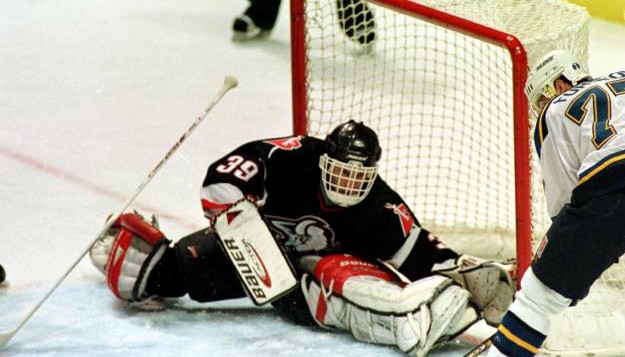Why the Sabres are Honoring Hasek, and Why the NHL Should Next
The Buffalo Sabres announced yesterday that they will be hanging jersey number 39 in the rafters during the 2014-2015 season. Outstanding goaltender Dominik Hasek will be the last to wear number 39 and his number and jersey will join Sabres greats Gilber Perreult (#11), Rick Martin (#7), Rene Robert (#14), Tim Horton (#2), Danny Gare (#18), and Pat LaFontaine (#16).
Hasek is being inducted into the Sabres Hall of Fame on Saturday, March 29th (NHL.com).
Not only was Hasek an outstanding goaltender for the Sabres, but he also played a lead role on the world stage. He redefined and reinvented the position of goaltending. Before Hasek, there were two styles of goaltender: stand-up (think Bill Ranford) or butterfly (think Patrick Roy). Hasek defied the rules and created his own style built upon instinct and information. Hasek realized that geometry dictated the possible path of each shot, and by understanding where the puck could go and where it could not go, Hasek was able to develop what is now known as the Hybrid Style of goaltending. Companies even started making a new style of pads to accommodate the new bread of youth goaltenders being raised on amazing, sprawling saves and blocker-hand puck covers.
Dominic Hasek was willing to break all the rules of goaltending in order to make a save. He was known to drop his stick to grab a loose puck with his blocker. He once pushed a net over from behind after getting caught with his pants down playing the puck out of his crease, because he knew he would stand a better chance of stopping the goal in a penalty shot (he stopped it). He was also able to kick his legs up in a somersault action in order to cover more of the net from his backside when a shot was raised up under the bar. This move was even christened the “Hasek Roll,” and it allowed the sprawling goaltender to recover immediately to his feet at the conclusion of the roll, ready to make another save. Most importantly, he will always be famous for his amazing, seemingly frantic rebound saves.
Hasek was a kind of “gumby” man who could contort his arms, legs, and torso toward any incoming pucks. While these saves became awe inspiring and appeared to show off a natural talent at work, Hasek’s skills were based on logic and math as well. By knowing when a shooter was too close to raise a puck over a sprawled pad, and understanding that a backhand rebound chance from the top of the circle can only travel in a straight line into his glove or over the net if he stands way outside of his crease, Hasek was able to redefine the position and dominate at a level no previous goaltender had before. Every time you see a goalie drop his inside leg when a skater moves aggressively from behind the net with the puck, and every time a goalie lays his back flat on the ice and “snowmans” his arms and legs into his body, you are seeing the influence Hasek has had on goaltending.
Hasek holds many records and is one of the most decorated goaltenders of all time. He has won six Vezina Trophies, given to the best goaltender in the league, (94, 95, 97, 98, 99, 01), the William M. Jennings Trophy, fewest goals against minimum 25 games played, (94, 01), and the Lester B. Pearson Award, most outstanding NHL player voted on by the NHL players association (97, 98). He is also the only goalie to win the Hart Memorial Trophy, awarded to the most outstanding player in the NHL each year (97,98).
Along with all his awards, Hasek set many Sabres franchise records including, most all time games played (491), shutouts (55), wins (234) and lowest goals against average (2.22). He set a team record of 13 shutouts during the 98-99 season, the same season he led the Sabres to the Stanley Cup Final.
After his time with the Sabres, Hasek went to the Detroit Red Wings where he won two Stanley Cups in 2002 and 2008. He appeared as an Ottawa Senator during the 2005-2006 season.
In international play, he led the Czech Republic to a gold medal in 1998. He was also a part of the Czech team that took home the bronze in 2006.
Dominik Hasek is not only held dear in the hearts of Sabres fans, but to the many young goaltenders who looked up to this legend and dreamed of competing the way he did. He has not only earned a place in the Sabres Hall of Fame, but he deserves a place in the Hockey Hall of Fame.














